 This comic—the only issue of What If? that takes place in the mainstream “616” Marvel Universe rather than creating new timelines with alternative versions of canonical stories—represents what may be the pinnacle of writer Roy Thomas’s original sense of retroactive continuity (or retconning) at Marvel, filling in details in old stories to address inconsistencies and gaps. In this case, Thomas is finishing a job begun in Captain America #153 by Steve Englehart (following Thomas’s suggestion): Explaining the appearances of Captain America and Bucky between 1945 and 1954 after Avengers #4 introduced the idea that the originals disappeared (and presumed dead) shortly before the end of World War II. Because Englehart’s tale only explained the identities of the Cap and Bucky who appeared in the comics of 1953-54, it was left to Thomas to explain the Cap and Bucky from 1945 to 1949… or should I say, the Caps and Bucky.
This comic—the only issue of What If? that takes place in the mainstream “616” Marvel Universe rather than creating new timelines with alternative versions of canonical stories—represents what may be the pinnacle of writer Roy Thomas’s original sense of retroactive continuity (or retconning) at Marvel, filling in details in old stories to address inconsistencies and gaps. In this case, Thomas is finishing a job begun in Captain America #153 by Steve Englehart (following Thomas’s suggestion): Explaining the appearances of Captain America and Bucky between 1945 and 1954 after Avengers #4 introduced the idea that the originals disappeared (and presumed dead) shortly before the end of World War II. Because Englehart’s tale only explained the identities of the Cap and Bucky who appeared in the comics of 1953-54, it was left to Thomas to explain the Cap and Bucky from 1945 to 1949… or should I say, the Caps and Bucky.
The story—led off, unfortunately, by the misleading “what if” title—begins with a now-familiar scene…

…with its inevitable conclusion.
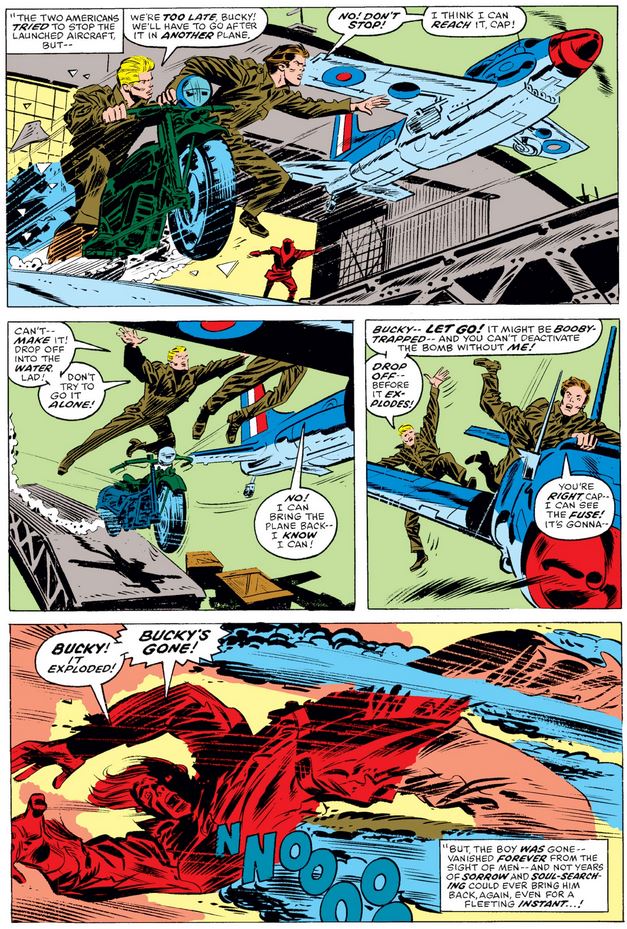
But this time, we get color commentary from the traditional narrator of What If?, Uatu the Watcher, who explains how the other Invaders’ lives proceeded after Cap and Bucky’s disappearance.

Most notably, the Human Torch and Toro had quite a day on April 30, 1945.
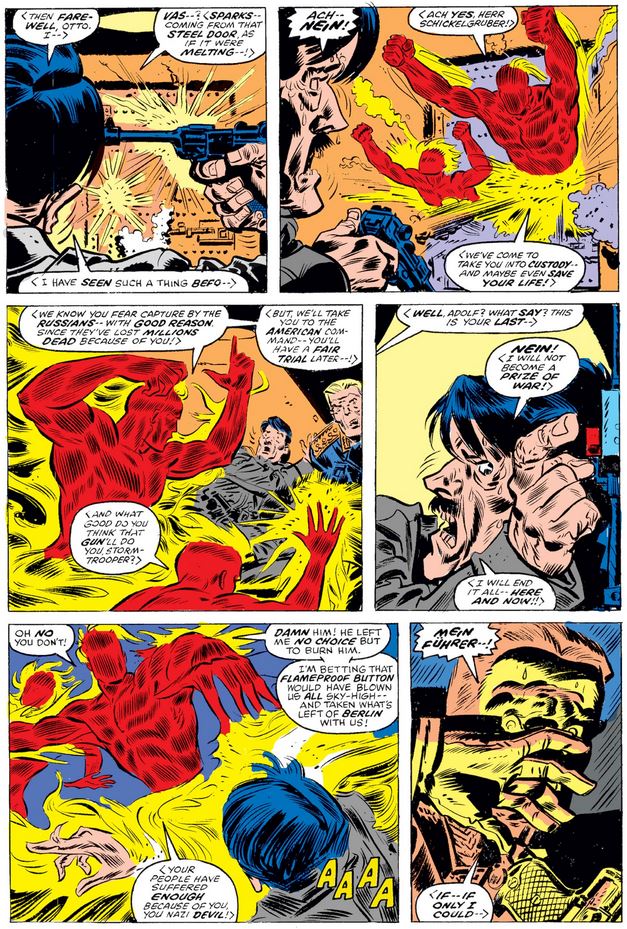
Yes, in the Marvel Universe, the original Human Torch killed Adolf Hitler, although this is unknown to the broader public, who still believe he committed suicide (as in our world). Presumably, they also don’t know that a Nazi invented dabbing.
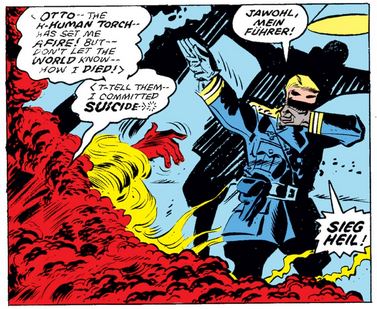
OK, back to Cap and Bucky… before long, the rest of the Invaders are summoned to London by their military liaisons and given the bad news.
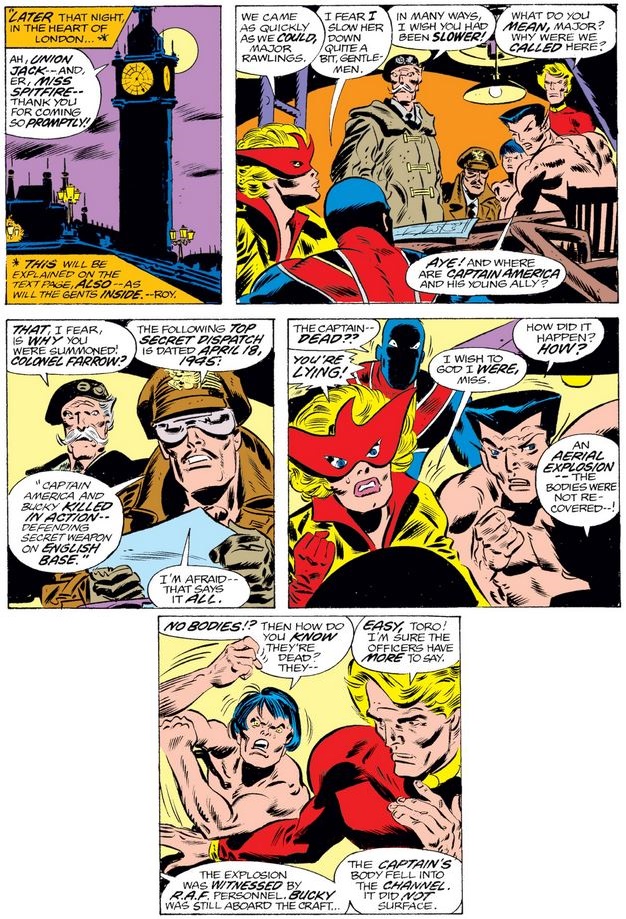
(They should’ve listened to Toro.)
While Spitfire and Union Jack remain in England, the rest of the Invaders fly to Washington, DC, on the orders of the new U.S. president, who mourns the presumed deaths of Steve Rogers and James Buchanan Barnes but does not want Captain America and Bucky to die.

And so he introduces v2.0, but they don’t fool Namor and the Torch for long.

Roy Thomas used his own creations for the new Cap and Bucky: William Naslund (the Spirit of ’76), who originated in Invaders #14-15 as a member of the Crusaders (an analogue of DC Comics’ Freedom Fighters), and Fred Davis, a batboy (but not a Robin) who was introduced in the Liberty Legion storyline in Invaders #5-6 and Marvel Premiere #29-30 (although Davis didn’t appear in the post).
The newly completed Invaders are soon joined by Miss America and the Whizzer, actual Golden Age Timely Comics characters who were members of the Liberty Legion, to bring their number back to seven (effectively replacing Spitfire and Union Jack). After some adventuring at the very end of the war, they receive a new team name from President Truman himself (explaining the appearance of a team of that name in Fall 1946’s All-Winners Comics #19).

After some more adventures, the Human Torch and Toro head to Boston to visit Professor Phineas T. Horton, the man who created the Torch, but instead they find an android impostor of Horton, followed by the android who created him… Adam-II.
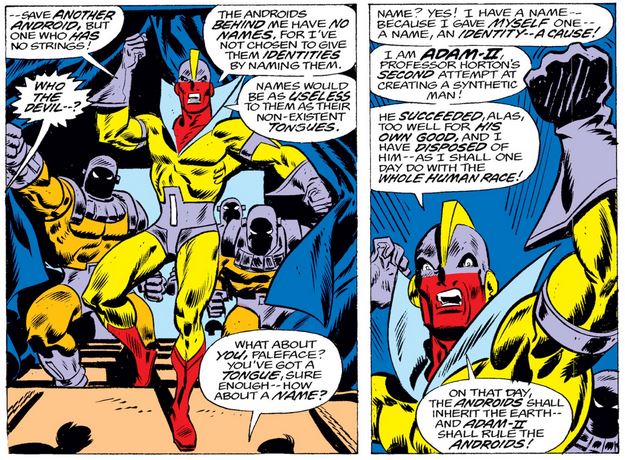
Adam-II and his nameless androids (rude) subdue Torch and Toro and dump them in a water tank with the real Horton. The Torch manages to flame up enough to set off Horton’s fire alarm, but instead of the heroes of the fire department, a masked hero answers the call instead: Jeff Mace, a.k.a. the Patriot, yet another original Golden Age hero and member of the Liberty Legion.
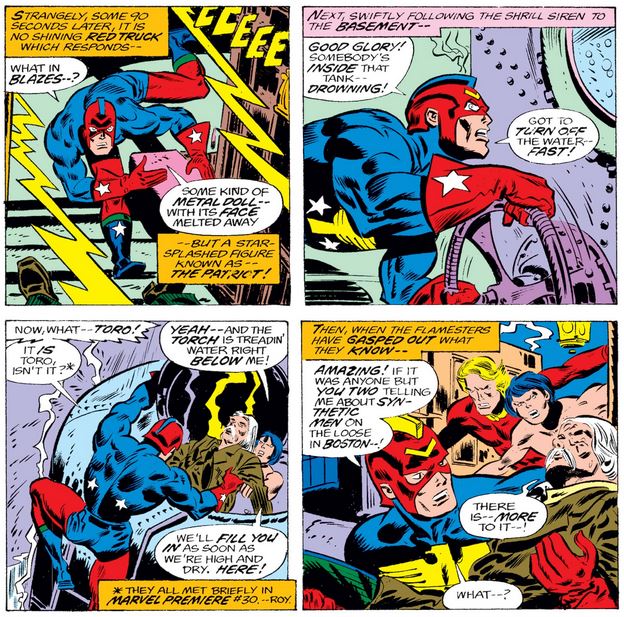
Horton tells the three heroes that Adam-II has substituted an android for a local politician, and when all of our cast assembles near the capital building in Boston, the Patriot can’t understand why his “old buddy” Cap doesn’t recognize him… and it hurts. (Dammit it hurts.)

The heroes split up to look into the ten Democratic candidates at the event, and Cap definitely recognizes the one assigned to him and Bucky. (Just don’t tell Patriot.)
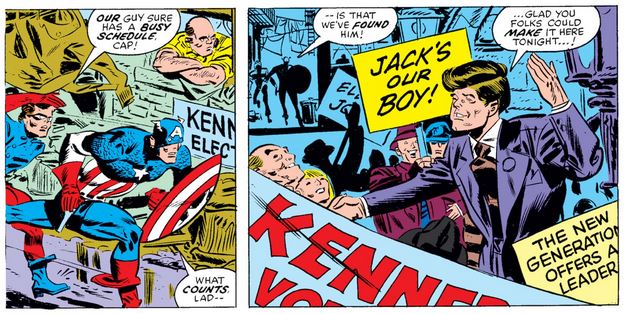
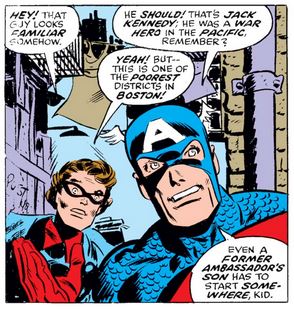
As it happens, JFK is the politician who was replaced with an android, leading to a cracking battle between Cap and Adam-II.
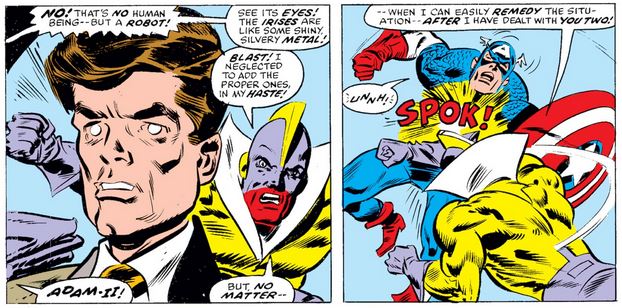
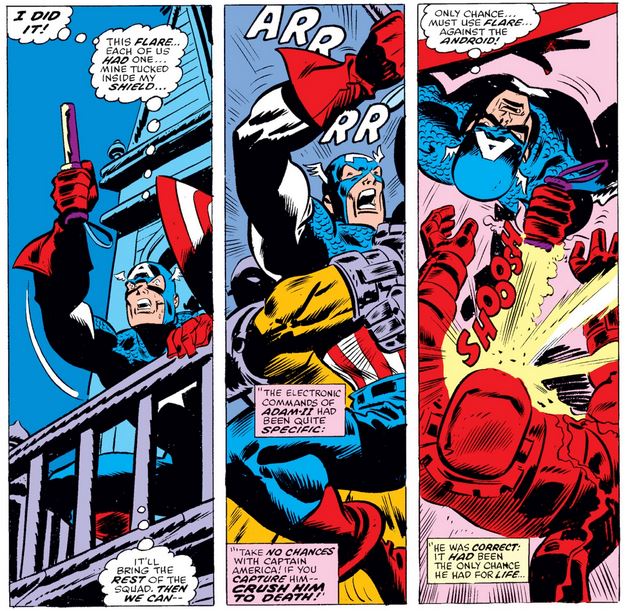
Fatally wounded, Cap uses his last bit of energy to send a warning to his fellow heroes.
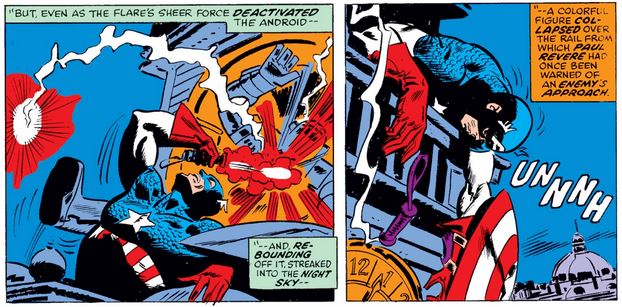
Cap’s teammates see his call and gather to fight Adam-II and his henchdroids, but as Adam-II moves to take care of the real JFK, he is surprised by the apparent return of a vanquished foe.

Adam-II flees in a car which skids in the oil leaked from his damaged androids, leading to a crash that presumably destroyed him. (That’s what you get for not giving them names… or faces, for that matter.) Have no worries: Although his body was destroyed, Adam-II’s “mind” survived, only to be refashioned as Adam-III and attack the original Cap and Human Torch alongside Fred Davis and William Naslund’s grandson in 2012’s Captain America and Bucky #625-628, collected here.
The crisis averted, young JFK thanks the heroes, including one who “frankly” can’t see why Adam-II saw him as the politician most likely to go far…

…before focusing on Cap himself, who, in revealing himself to be the Patriot, also reveals what happened to William Naslund.
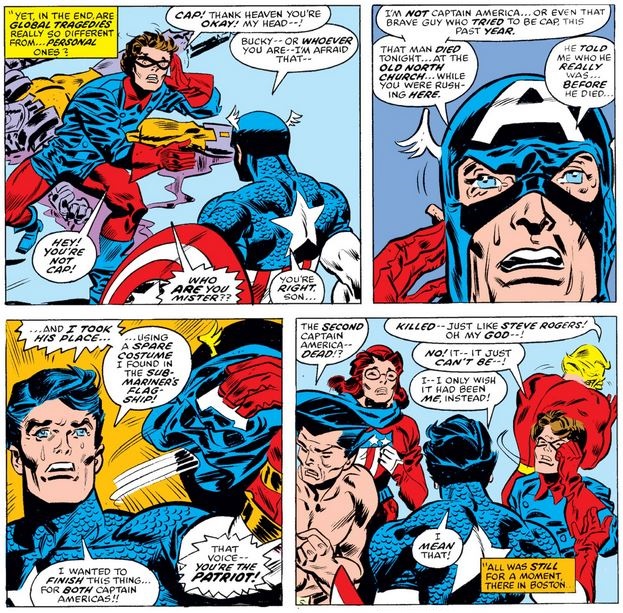
The issue ends with the following image, narrated by the Watcher, drawing an analogy between the two deceased Captains America and the two Kennedy brothers, John and Bobby, who would be assassinated two decades later.

That’s an interesting twist on the final line of John Milton’s Sonnet 19: “They also serve who only stand and wait.” Very fitting for the Watcher, who is bound to observe without interfering—although this Watcher in particular is uncharacteristically proactive, as we saw in Avengers #101. (And a nice visual reference to Michaelangelo’s Pietà as well, courtesy of the Franks Robbins and Springer. No one ever did that again in comics, that’s for sure.)
After serving as Captain America from 1946 to 1949, Jeff Mace made several appearances in the “modern” Marvel Universe, and enjoyed his own miniseries, set in the 1940s but published in 2020-11, titled Captain America: Patriot; several younger heroes would take up the name in recent years. (And William Naslund’s grandson shows up later as well, as noted above.)
You might be asking: Why did Roy Thomas need two guys to be Cap in the late 1940s? We can presume he would have preferred to use an established Timely Comics hero, such as the Patriot, rather than his own recent creation, the Spirit of ’76. However, the Patriot was active in the comics through July 1946’s Marvel Mystery Comics #74, so according to his own rules of retroactive continuity, Roy needed another hero to fill in as Cap between May 1945 and then. This makes me suspect that he created the Spirit of ’76 for just this purpose, considering he was introduced in a comic (Invaders #14) that came out just five months before this one.
ISSUE DETAILS
What If? (vol. 1) #4, August 1977: Roy Thomas (writer), Frank Robbins (pencils), Frank Springer (inks), George Roussos (colors), Joe Rosen and John Costanza (letters). (More details at Marvel Database.)
Collected in: Invaders Classic: The Complete Collection Volume 2 and What If? Classic: The Complete Collection Vol. 1
ALSO THIS MONTH: Captain America #212, Avengers #162, and Invaders #19 (August 1977)
Leave a comment